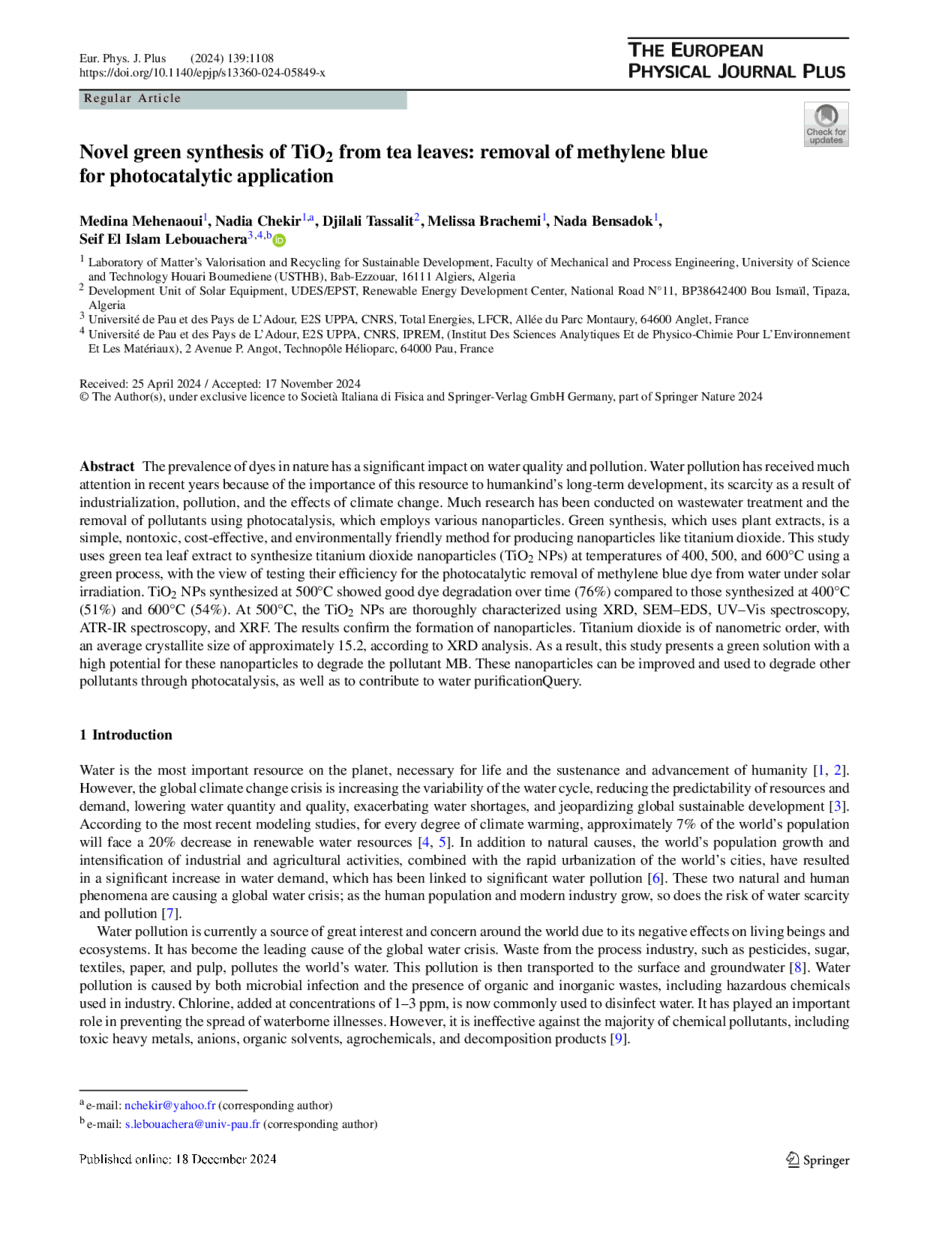https://doi.org/10.1140/epjp/s13360-024-05849-x
Regular Article
Novel green synthesis of TiO2 from tea leaves: removal of methylene blue for photocatalytic application
1
Laboratory of Matter’s Valorisation and Recycling for Sustainable Development, Faculty of Mechanical and Process Engineering, University of Science and Technology Houari Boumediene (USTHB), Bab-Ezzouar, 16111, Algiers, Algeria
2
Development Unit of Solar Equipment, UDES/EPST, Renewable Energy Development Center, National Road N°11, BP38642400, Bou Ismaïl, Tipaza, Algeria
3
Université de Pau et des Pays de L’Adour, E2S UPPA, CNRS, Total Energies, LFCR, Allée du Parc Montaury, 64600, Anglet, France
4
Université de Pau et des Pays de L’Adour, E2S UPPA, CNRS, IPREM, (Institut Des Sciences Analytiques Et de Physico-Chimie Pour L’Environnement Et Les Matériaux), 2 Avenue P. Angot, Technopôle Hélioparc, 64000, Pau, France
a
nchekir@yahoo.fr
b
s.lebouachera@univ-pau.fr
Received:
25
April
2024
Accepted:
17
November
2024
Published online:
18
December
2024
The prevalence of dyes in nature has a significant impact on water quality and pollution. Water pollution has received much attention in recent years because of the importance of this resource to humankind’s long-term development, its scarcity as a result of industrialization, pollution, and the effects of climate change. Much research has been conducted on wastewater treatment and the removal of pollutants using photocatalysis, which employs various nanoparticles. Green synthesis, which uses plant extracts, is a simple, nontoxic, cost-effective, and environmentally friendly method for producing nanoparticles like titanium dioxide. This study uses green tea leaf extract to synthesize titanium dioxide nanoparticles (TiO₂ NPs) at temperatures of 400, 500, and 600°C using a green process, with the view of testing their efficiency for the photocatalytic removal of methylene blue dye from water under solar irradiation. TiO₂ NPs synthesized at 500°C showed good dye degradation over time (76%) compared to those synthesized at 400°C (51%) and 600°C (54%). At 500°C, the TiO₂ NPs are thoroughly characterized using XRD, SEM–EDS, UV–Vis spectroscopy, ATR-IR spectroscopy, and XRF. The results confirm the formation of nanoparticles. Titanium dioxide is of nanometric order, with an average crystallite size of approximately 15.2, according to XRD analysis. As a result, this study presents a green solution with a high potential for these nanoparticles to degrade the pollutant MB. These nanoparticles can be improved and used to degrade other pollutants through photocatalysis, as well as to contribute to water purificationQuery.
Copyright comment Springer Nature or its licensor (e.g. a society or other partner) holds exclusive rights to this article under a publishing agreement with the author(s) or other rightsholder(s); author self-archiving of the accepted manuscript version of this article is solely governed by the terms of such publishing agreement and applicable law.
© The Author(s), under exclusive licence to Società Italiana di Fisica and Springer-Verlag GmbH Germany, part of Springer Nature 2024
Springer Nature or its licensor (e.g. a society or other partner) holds exclusive rights to this article under a publishing agreement with the author(s) or other rightsholder(s); author self-archiving of the accepted manuscript version of this article is solely governed by the terms of such publishing agreement and applicable law.





